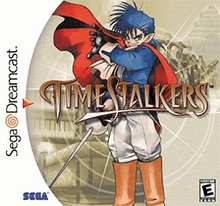Time Stalkers
| Time Stalkers | |
|---|---|
 North American Dreamcast cover art | |
| Developer(s) | Climax Entertainment |
| Publisher(s) | Sega |
| Platform(s) | Dreamcast |
| Release | |
| Genre(s) | Roguelike RPG |
| Mode(s) | Single-player |
Time Stalkers, also known as Climax Landers (クライマックス ランダーズ)[1] in Japan, is a Dreamcast role-playing video game featuring appearances of worlds (and playable characters) from several of Climax Entertainment's earlier games in crossover fashion. The player initially takes the role of Sword, a character caught in a world made of many worlds. As he goes along, similar heroes show up for the player to control. The player may do things such as enter dungeons, take special assignments, and upgrade/buy/sell items.
Gameplay
Time Stalkers is a typical Roguelike. The game also borrows elements from Dragon Quest V because players can capture enemies and build a party of monsters. Players can carry up to 8 monsters, but are only allowed to have two with them during battles.
Reception
Time Stalkers was met with mixed to negative reviews. Pete Bartholow of GameSpot gave the game a negative review, criticizing its "traditional" story, randomized dungeon layouts, ugly graphics, and most particularly the resetting of experience points at the beginning of each dungeon. He concluded by advising gamers to instead get the "vastly superior" Evolution: The World of Sacred Device (the Dreamcast's only other RPG at that time), and gave Time Stalkers an overall score of 5.2.[2] IGN gave the game a 6.5, and praised the unique overworld and the monster capture mechanic. However, like GameSpot, they took issue with the resetting of experience points, and also complained of the game's concise dialogue and short length.[3]
References
- ↑ "Game data". GameFAQs. Retrieved 2008-02-20.
- ↑ Bartholow, Peter (November 16, 1999). "Time Stalkers Review". GameSpot. Retrieved 8 September 2013.
- ↑ "Time Stalkers (aka Climax Landers)". IGN. April 5, 2000. Retrieved 8 September 2013.